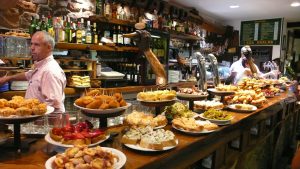
Toledo the city of three cultures
Toledo, like other Spanish cities such as Seville, has had for centuries the coexistence of the three Abrahamic religions: Christianity, Islam and Judaism.
While it is true that some periods have been more peaceful than others, and relations between their citizens more or less open. From this coexistence, a rich cultural and artistic heritage has emerged.
Jewish Toledo
Toledo is one of the Spanish cities that preserve the greatest Jewish heritage standing. In the 14th century Toledo had ten synagogues, of which two are in good condition, although they were transformed into churches and are currently desacralized. Jewish Toledo One of them is the Synagogue de Santa María la Blanca, formerly the Major Synagogue. It is of a unique beauty, its white arches and plasterwork are like a snowy forest, a visit inside is essential. The other Synagogue is that of Samuel ha-Leví, today the Sephardic Museum. It preserves the Hejal, polychrome plasterwork, a coffered ceiling with inscriptions in Hebrew. The majesty of the building is the best imaginable continent for this museum, which brings us closer to learning about Jewish life in Sepharad.
Islamic Toledo
The Mosque Bad Al Mardum is the most representative monument that still stands is the Bad Al Mardum Mosque, built in 999. It is a small mosque, with a quadrangular plan, with the enigmatic characteristic that its quibla does not face the Mecca, something that also happens in other mosques in Al-Andalus. But the Muslim legacy is not only limited to properly Muslim buildings, such as the Almohad style so present in Seville, but in Toledo Mudejar art is present in every corner, including churches and synagogues.
Christian Toledo
Like the rest of Spain, society was and is mainly Christian, so the best preserved heritage is undoubtedly the Christian. Toledo was the capital for centuries, which made the power of all the religious orders very present here, so countless churches and monasteries are scattered throughout the city. In 1561 the court moved to Madrid and the nobles and religious orders did the same, leaving Toledo somehow “frozen in time”, allowing us today to enjoy all that previous heritage.
If you want to visit Toledo, here you can see more information about some tours here: Toledo Guided Tour and Excursion to Toledo, Segovia & Avila.

Toledo the city of three cultures
Toledo, like other Spanish cities such as Seville, has had for centuries the coexistence of the three Abrahamic religions: Christianity, Islam and Judaism.
While it is true that some periods have been more peaceful than others, and relations between their citizens more or less open. From this coexistence, a rich cultural and artistic heritage has emerged.
Jewish Toledo
Toledo is one of the Spanish cities that preserve the greatest Jewish heritage standing. In the 14th century Toledo had ten synagogues, of which two are in good condition, although they were transformed into churches and are currently desacralized. Jewish Toledo One of them is the Synagogue de Santa María la Blanca, formerly the Major Synagogue. It is of a unique beauty, its white arches and plasterwork are like a snowy forest, a visit inside is essential. The other Synagogue is that of Samuel ha-Leví, today the Sephardic Museum. It preserves the Hejal, polychrome plasterwork, a coffered ceiling with inscriptions in Hebrew. The majesty of the building is the best imaginable continent for this museum, which brings us closer to learning about Jewish life in Sepharad.
Islamic Toledo
The Mosque Bad Al Mardum is the most representative monument that still stands is the Bad Al Mardum Mosque, built in 999. It is a small mosque, with a quadrangular plan, with the enigmatic characteristic that its quibla does not face the Mecca, something that also happens in other mosques in Al-Andalus. But the Muslim legacy is not only limited to properly Muslim buildings, such as the Almohad style so present in Seville, but in Toledo Mudejar art is present in every corner, including churches and synagogues.
Christian Toledo
Like the rest of Spain, society was and is mainly Christian, so the best preserved heritage is undoubtedly the Christian. Toledo was the capital for centuries, which made the power of all the religious orders very present here, so countless churches and monasteries are scattered throughout the city. In 1561 the court moved to Madrid and the nobles and religious orders did the same, leaving Toledo somehow “frozen in time”, allowing us today to enjoy all that previous heritage.
If you want to visit Toledo, here you can see more information about some tours here: Toledo Guided Tour and Excursion to Toledo, Segovia & Avila.


